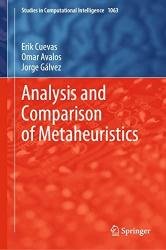Analysis and Comparison of Metaheuristics
- Добавил: literator
- Дата: 8-11-2022, 01:51
- Комментариев: 0
 Название: Analysis and Comparison of Metaheuristics
Название: Analysis and Comparison of MetaheuristicsАвтор: Erik Cuevas, Omar Avalos, Jorge Galvez
Издательство: Springer
Серия: Studies in Computational Intelligence
Год: 2023
Страниц: 230
Язык: английский
Формат: pdf (true)
Размер: 10.1 MB
This book presents a comparative perspective of current metaheuristic developments, which have proved to be effective in their application to several complex problems. The study of biological and social entities such as animals, humans, or insects that manifest a cooperative behavior has produced several computational models in metaheuristic methods. Although these schemes emulate very different processes or systems, the rules used to model individual behavior are very similar. Under such conditions, it is not clear to identify which are the advantages or disadvantages of each metaheuristic technique. The book is compiled from a teaching perspective. For this reason, the book is primarily intended for undergraduate and postgraduate students of Science, Electrical Engineering, or Computational Mathematics. It is appropriate for courses such as Artificial Intelligence, Electrical Engineering, Evolutionary Computation. The book is also useful for researchers from the evolutionary and engineering communities. Likewise, engineer practitioners, who are not familiar with metaheuristic computation concepts, will appreciate that the techniques discussed are beyond simple theoretical tools since they have been adapted to solve significant problems that commonly arise in engineering areas.
The purpose of computational metaheuristic schemes is to model the simple behaviors of agents and their local interactions with other neighboring agents to perform an effective search strategy for solving optimization problems. One example of these mechanisms is the Particle Swarm Optimization (PSO), which models two simple actions. Each agent (1) moves toward the best agent of the population, and (2) moves toward the position where the agent has reached its best location. As a consequence, the collective behavior of the group produces that all agents are attracted to the best positions experimented with by all elements. Another example is the ant colony optimization (ACO), which models the biological pheromone trail following the behavior of ants. Under this mechanism, each ant senses pheromone concentrations in its local position. Then, it probabilistically selects the path with the highest pheromone concentration. Considering this model, the collective effect in the population is to find the best option (shortest path) from a group of alternatives available in a decision-making problem.
There exist several features that clearly appear in most of the metaheuristic approaches, such as the use of diversification to force the exploration of regions of the search space, rarely visited until now, and the use of intensification or exploitation, to investigate some promising regions thoroughly. Another interesting feature is the use of memory to store the best solutions encountered. For these reasons, metaheuristics methods quickly became popular among researchers to solve simple to complex optimization problems in different areas.
Chapter 4 presents a comparative analysis of the application of five recent metaheuristic schemes to the shape recognition problem such as the Grey Wolf Optimizer (GWO), Whale Optimizer Algorithm (WOA), Crow Search Algorithm (CSA), Gravitational Search Algorithm (GSA), and Cuckoo Search (CS). Since such approaches have been successful in several new applications, the objective is to determine their efficiency when they face a complex problem such as shape detection. Numerical simulations, performed on a set of experiments composed of images with different difficulty levels demonstrate the capacities of each approach. Shape recognition in images represents one of the complex and hard-solving problems in computer vision due to its nonlinear, stochastic, and incomplete nature.
The goal of this book is to present a comparative perspective of current metaheuristic developments, which have proved to be effective in their application to several complex problems. The book considers different metaheuristic methods and their practical applications. This structure is important to us because we recognize this methodology as the best way to assist researchers, lecturers, engineers, and practitioners in the solution of their own optimization problems.
Скачать Analysis and Comparison of Metaheuristics
Внимание
Уважаемый посетитель, Вы зашли на сайт как незарегистрированный пользователь.
Мы рекомендуем Вам зарегистрироваться либо войти на сайт под своим именем.
Уважаемый посетитель, Вы зашли на сайт как незарегистрированный пользователь.
Мы рекомендуем Вам зарегистрироваться либо войти на сайт под своим именем.
Информация
Посетители, находящиеся в группе Гости, не могут оставлять комментарии к данной публикации.
Посетители, находящиеся в группе Гости, не могут оставлять комментарии к данной публикации.
